Olympus M.ZUIKO Digital 12-40mm f/2.8 Pro Review

Introduction
The Olympus M.ZUIKO Digital 12-40mm f/2.8 Pro is weather-sealed professional standard zoom lens for the Micro Four Thirds system. Offering a 35mm equivalent focal range of 24-80mm, the Olympus M.ZUIKO Digital 12-40mm f/2.8 Pro offers constant maximum aperture of f/2.8 throughout its zoom range, fast and quiet auto focusing and an optical formula comprising 14 elements arranged in 9 groups, including 1 aspherical element, 1 dual-sided aspherical element, 2 ED glass elements, 2 HR glass elements, 1 EDA glass element and 1 HD glass element. Other highlights include a manual focus clutch mechanism, and a customisable L-Fn button that can be used to temporarily suspend continuous auto focus when something suddenly comes between the lens and your intended subject while recording video with your camera. In the UK the Olympus M.ZUIKO Digital 12-40mm f/2.8 Pro lens is available in a bundle with the Olympus OM-D E-M1 compact system camera, or seperately for £899.99. In the US, the lens is sold separately for around $999.
Ease of Use
The Olympus M.ZUIKO Digital 12-40mm f/2.8 Pro is a weather sealed lens with a dedicated Micro Four Thirds mount. Note however that in order to take full advantage of the weatherproofing, you will need to mount it on a similarly sealed body, like the flagship OM-D E-M1 that we tested it with.
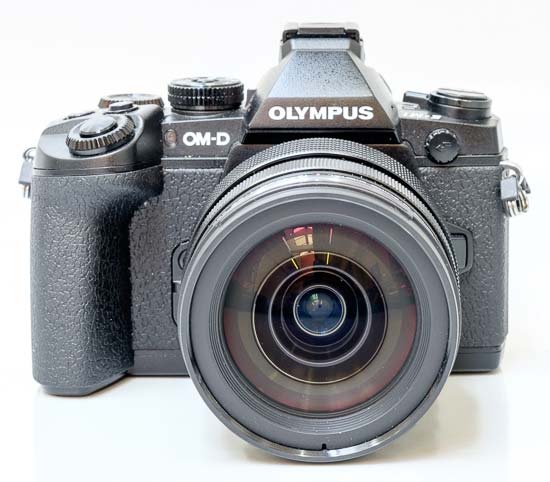 The Olympus M.ZUIKO Digital 12-40mm f/2.8 Pro lens attached to an Olympus OM-D E-M1
The Olympus M.ZUIKO Digital 12-40mm f/2.8 Pro lens attached to an Olympus OM-D E-M1
 The Olympus M.ZUIKO Digital 12-40mm f/2.8 Pro lens attached to an Olympus OM-D E-M1
The Olympus M.ZUIKO Digital 12-40mm f/2.8 Pro lens attached to an Olympus OM-D E-M1
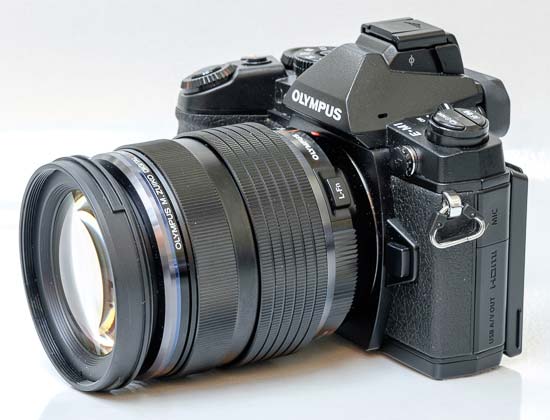 The Olympus M.ZUIKO Digital 12-40mm f/2.8 Pro lens attached to an Olympus OM-D E-M1
The Olympus M.ZUIKO Digital 12-40mm f/2.8 Pro lens attached to an Olympus OM-D E-M1
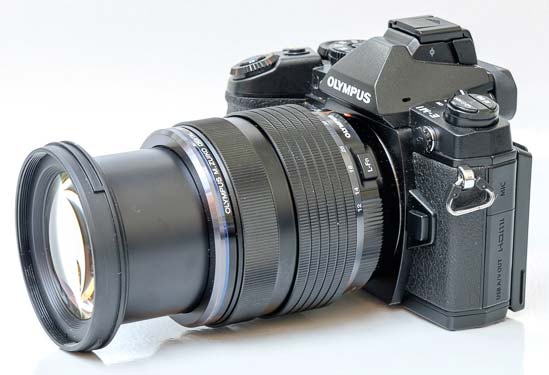 The Olympus M.ZUIKO Digital 12-40mm f/2.8 Pro lens attached to an Olympus OM-D E-M1, extended to 40mm
The Olympus M.ZUIKO Digital 12-40mm f/2.8 Pro lens attached to an Olympus OM-D E-M1, extended to 40mm
 The Olympus M.ZUIKO Digital 12-40mm f/2.8 Pro lens alongside an Olympus OM-D E-M1
The Olympus M.ZUIKO Digital 12-40mm f/2.8 Pro lens alongside an Olympus OM-D E-M1
Tipping the scales at 382 grams and measuring 84mm in length and 70mm in diameter, the Olympus M.ZUIKO Digital 25mm f/1.8 is quite a substantial standard zoom lens, but given the constant f/2.8 maximum aperture, that's perhaps no surprise. When it's zoomed out to 40mm, it measures nearly 13cms in length.
The Olympus OM-D E-M1 used for this test is a great match for the lens, offering good balance, fast auto focus, and full environmental seals. The M.ZUIKO Digital 12-40mm f/2.8 Pro lens itself is very well built, fully living up to the PRO designation that Olympus have given it.
 Front of the Olympus M.ZUIKO Digital 12-40mm f/2.8 Pro lens
Front of the Olympus M.ZUIKO Digital 12-40mm f/2.8 Pro lens
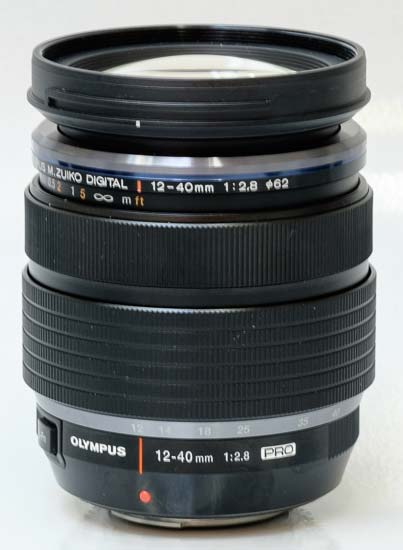 Front of the Olympus M.ZUIKO Digital 12-40mm f/2.8 Pro lens, manual focus collar engaged
Front of the Olympus M.ZUIKO Digital 12-40mm f/2.8 Pro lens, manual focus collar engaged
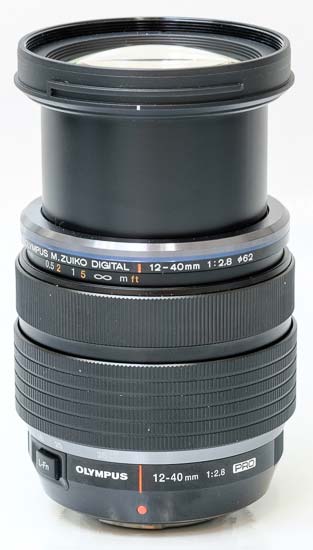 Front of the Olympus M.ZUIKO Digital 12-40mm f/2.8 Pro lens, extended to 40mm
Front of the Olympus M.ZUIKO Digital 12-40mm f/2.8 Pro lens, extended to 40mm
In terms of features, the M.ZUIKO Digital 12-40mm f/2.8 Pro lens has quite a lot to offer. For starters, it has a so-called L-Fn button, which allows users to temporarily suspend continuous auto focus when something suddenly comes between the lens and your intended subject. This is mostly useful when shooting a movie clip with C-AF enabled, but the feature can also be used when photographing action.
 Front of the Olympus M.ZUIKO Digital 12-40mm f/2.8 Pro lens
Front of the Olympus M.ZUIKO Digital 12-40mm f/2.8 Pro lens
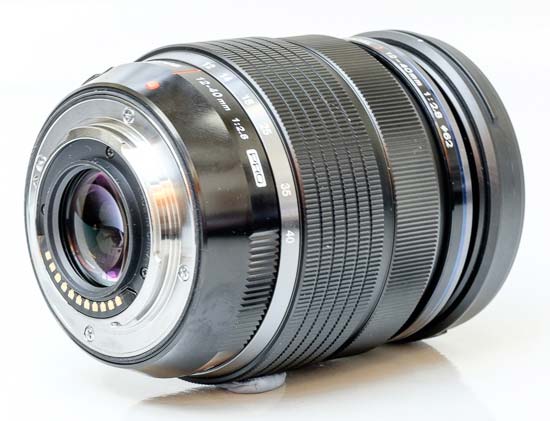 Rear of the Olympus M.ZUIKO Digital 12-40mm f/2.8 Pro lens
Rear of the Olympus M.ZUIKO Digital 12-40mm f/2.8 Pro lens
As with all Olympus M-Zuiko lenses, the 12-40mm f/2.8 Pro does not offer image stabilisation. Instead this is provided by the camera body, in this instance the excellent 5-axis system in the OM-D E-M1. So while the lack of in-lens image stabilisation is a non-issue for Olympus camera owners, other manufacturers who don't offer in-camera image stabilisation, like Panansonic (except for the GX7) may want to consider a different lens.
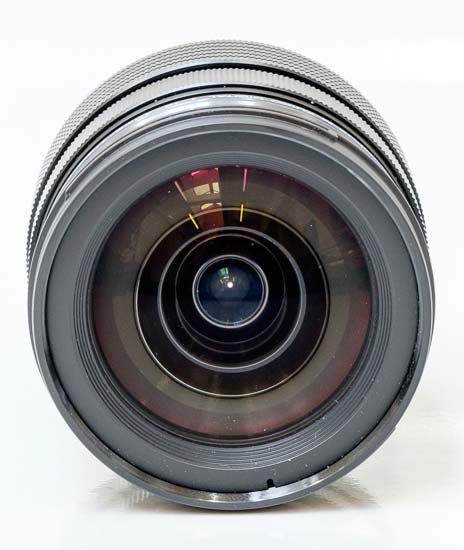 Front of the Olympus M.ZUIKO Digital 12-40mm f/2.8 Pro lens
Front of the Olympus M.ZUIKO Digital 12-40mm f/2.8 Pro lens
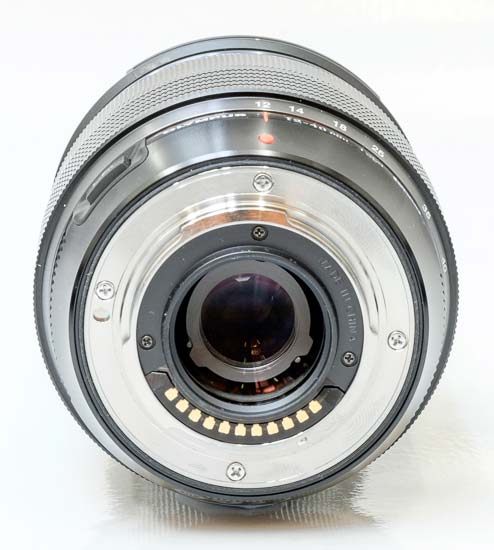 Rear of the Olympus M.ZUIKO Digital 12-40mm f/2.8 Pro lens
Rear of the Olympus M.ZUIKO Digital 12-40mm f/2.8 Pro lens
The Olympus M.ZUIKO Digital ED 12-40mm f/3.5-6.3 EZ lens features a 62mm filter thread and a front bayonet for attaching the supplied LH-66 hood, which has two buttons on opposite sides to lock and release it from the lens. The filter thread does not rotate on focus, which is great news for anyone intending to use a polariser or ND grads on the lens.
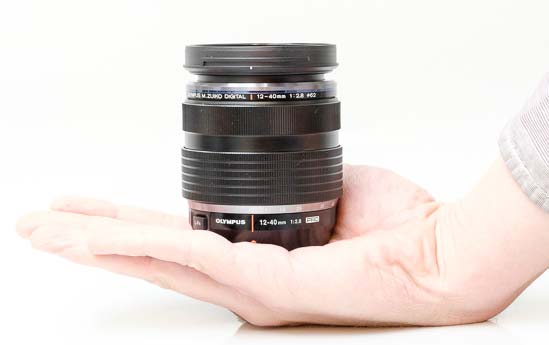 The Olympus M.ZUIKO Digital 12-40mm f/2.8 Pro lens in-hand
The Olympus M.ZUIKO Digital 12-40mm f/2.8 Pro lens in-hand
 The Olympus M.ZUIKO Digital 12-40mm f/2.8 Pro lens with the LH-66 lens hood fitted
The Olympus M.ZUIKO Digital 12-40mm f/2.8 Pro lens with the LH-66 lens hood fitted
 The Olympus M.ZUIKO Digital 12-40mm f/2.8 Pro lens with the LH-66 lens hood fitted
The Olympus M.ZUIKO Digital 12-40mm f/2.8 Pro lens with the LH-66 lens hood fitted
The lens comes with a standard Micro Four Thirds mount that is, as you'd expect, made of metal, with a rubber seal around the mount. Communication between lens and camera body is provided through eleven electrical contacts.
Focal Range
The lens has a versatile focal range. At the 12mm end, the diagonal angle of view is 84°, i.e. the same as that of a 24mm lens in a 35mm system.
 Field of view at 12mm
Field of view at 12mm
At the 40mm end, the angle of view is 30°, i.e. the same as that of an 80mm lens in a 35mm system.
 Field of view at 40mm
Field of view at 40mm
Focusing
With the 12-40mm lens attached to an Olympus OM-D E-M1 body, focusing is extremely quick in most situations.The camera-lens combo is capable of locking focus on a subject almost instantly, even when alternating between close and faraway subjects. In extreme low-light situations you may experience a little focus hunting at the long end, but the constant f/2.8 maximum aperture nearly always allows enough light to pass through to the sensor.
Manual focusing is done in a traditional fashion, with the generously sized focus ring mechanically coupled to the moving lens elements, complete with hard stops at either end. The lens also usefully features a distance scale, which is cleverly revealed by pulling back the Manual Focus Collar to instantly engage manual focusing. Like zooming, focusing is fully internal and the filter thread does not rotate on focus.
Chromatic Aberrations
Chromatic aberrations, typically seen as purple or green fringes along contrasty edges, areonly really noticeable by their almost complete absence from our test images.
 |
 |
Light Fall-off
There is only a minimum of light fall-off in the corners, which you will probably not even notice in your real-world photos, and distortion is commendably kept well under control too.
 Vignetting at 12mm
Vignetting at 12mm
 Vignetting at 40mm
Vignetting at 40mm
Macro
The Olympus M.ZUIKO Digital 12-40mm f/2.8 Pro is actually a good macro lens, offering a minimum focusing distance of 20cm and a maximum magnification of 0.3x. The following example demonstrates how close you can get to your subject, in this case a Compact Flash memory card. As you can see, if you set the lens to the maximum 40mm telephoto focal length, you can actually fill most of the frame.
 Close-up performance
Close-up performance
Bokeh
Bokeh is a word used for the out-of-focus areas of a photograph, and is usually described in qualitative terms, such as smooth / creamy / harsh etc. In the M.ZUIKO Digital 12-40mm f/2.8 Pro, Olympus employed a seven circular-bladed diaphragm, which produces some very nice bokeh, at least in our opinion. However, recognising that bokeh evaluation is subjective, we have provided a few examples for your perusal.
 |
 |
 |
 |
Sharpness
In order to show you how sharp this lens is, we are providing 100% crops on the following pages.
